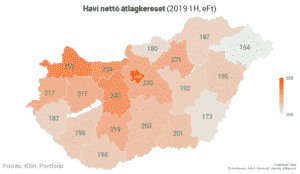Which are the poorest and richest Hungarian regions? See map inside!
In the first half of this year, wages rose rapidly in Hungary, partly due to the rise of the national minimum wage and labour shortages. However, income inequality is still very high in Hungary. But which regions of the country are the poorest and richest?
As reported by portfolio.hu, the salaries of people in lower income bracket saw an 8-8.8% increase in their wages, which is largely attributed to employers finding it more and more difficult to meet their labour demands.
Incomes are generally higher in the private sector than in the public sector, meaning that over the course of the past few months, firms that operate in the former are finding it easier to tackle labour shortages.
However, how does income vary across the country? Based on statistics from the Hungarian Central Statistical Office (KSH), the average net income in Budapest in the first half of 2019 was at €900 (300,000ft) a month, which is 1.8 times higher than in the county of Szabolcs-Szatmár-Bereg (Eastern Hungary), where average salaries were at a lowly €490 (164,000ft) a month. Salaries tend be highest in North-western Hungary – mostly attributed to multinational companies being located there – while people living in peripheral regions far away from the capital take home the lowest wages (see map).

More worryingly, only 3 out of the 19 Hungarian counties were able to reach the national average income of €720 (239,000ft) per month in the first half of 2019. Indeed, the national average is pushed up by the high salaries in Budapest, making the €720 average very unrepresentative of the country as a whole.
Other interesting statistics from the data:
- There is still a considerable gender pay gap. On average, women only earn 83% of men’s salaries and they have also experienced a lower rise in income – men’s and women’s income grew by 11% and 9.6% respectively.
-
Young people (aged below 25) experienced the highest rise in income at 17%, while individuals over 54 received the lowest rise in wages at 10%.
What can we take away from this?
Hungary needs to encourage investment into peripheral regions that are the furthest away from Budapest, thus enabling wages to be levelled across the whole country. In addition, the sharp rise in income experienced by young people could help encourage young professionals and recent university graduates to stay in Hungary and not consider employment opportunities abroad.
This week we wrote that guest workers earned record high wages last year. We also reported where most Hungarians move domestically.





